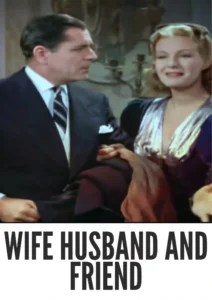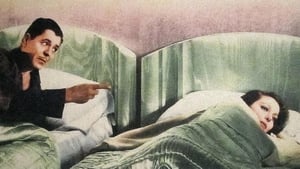Contact: info@alwanfilm.com
Video Sources 0 Views

Wife Husband and Friend 1939 Colorized
Synopsis
Review: Wife Husband and Friend 1939 Colorized – Exploring the Impact of Classic Screwball Comedy

Introduction
In the realm of classic cinema, “Wife, Husband, and Friend” (1939) stands out as a quintessential example of the screwball comedy genre. Directed by Gregory Ratoff, this film combines sharp wit, clever dialogue, and memorable performances to create a timeless narrative that continues to resonate with audiences today. This article delves into the significance of “Wife, Husband, and Friend,” exploring its cast, plot, themes, and the enduring impact it has had on the genre and beyond.
Check The Full Colorized Movies List
Check Our Colorized Movies Trailer Channel
Understanding Wife Husband and Friend 1939 Colorized: Director, Cast, and Genre
“Wife, Husband, and Friend” is a testament to the comedic genius of Gregory Ratoff, a director known for his ability to balance humor and narrative depth. The film features a stellar cast, with Loretta Young as Doris Borland, Warner Baxter as Leonard Borland, and Binnie Barnes as Cecil Carver. Each actor brings a unique charm and energy to their roles, contributing to the film’s lasting appeal.
As a screwball comedy, the film embodies the characteristics that define the genre: rapid-fire dialogue, improbable situations, and a blend of romantic and farcical elements. It is a genre that thrived during the Great Depression, providing audiences with much-needed laughter and escapism.
Exploring the World of Wife Husband and Friend 1939 Colorized: Plot and Characters
The plot of “Wife, Husband, and Friend” revolves around Leonard Borland (Warner Baxter), a businessman who discovers his talent for opera singing. His wife, Doris (Loretta Young), is also an aspiring singer, but without much talent. When Leonard’s hidden talent is revealed, he and his wife become entangled in a series of comedic misadventures that test their marriage and ambitions.
Leonard’s unexpected success as a singer leads to tensions with Doris, who becomes increasingly jealous and competitive. Enter Cecil Carver (Binnie Barnes), a sophisticated opera singer who takes Leonard under her wing, further complicating the couple’s relationship. The interactions between these characters create a delightful mix of humor, romance, and rivalry.
The Art of Screwball Comedy
Screwball comedy, a sub-genre of romantic comedy, emerged in the 1930s as a response to the economic hardships of the Great Depression. It is characterized by its witty dialogue, fast-paced humor, and unconventional romantic entanglements. The genre often features strong, independent female characters and bumbling, yet endearing male leads, creating a dynamic interplay that drives the narrative.
“Wife, Husband, and Friend” exemplifies the screwball comedy’s ability to balance humor with insightful commentary on social norms and relationships. The film’s clever dialogue and comedic timing highlight the absurdity of societal expectations and the complexities of marital dynamics.
Early Screwball Comedies: A Brief History
The screwball comedy genre emerged in the early 1930s, with films like “It Happened One Night” (1934) and “Bringing Up Baby” (1938) setting the standard for this new form of comedy. These films broke away from traditional romantic tropes, offering audiences a fresh and irreverent take on love and relationships.
The genre’s popularity can be attributed to its ability to provide escapism and laughter during a time of economic uncertainty. Screwball comedies often featured characters from different social classes, highlighting the clash between wealth and poverty, tradition and modernity. This blend of humor and social commentary resonated with audiences, making the genre a staple of 1930s and 1940s cinema.
Wife, Husband, and Friend and Its Place in Screwball Comedy
“Wife, Husband, and Friend” occupies a unique position within the screwball comedy genre, combining elements of romantic farce with a satirical look at artistic ambition and marital discord. The film’s exploration of gender roles and the competitive nature of relationships adds depth to its comedic surface, making it a standout entry in the genre.
The decision to focus on the world of opera singing adds a layer of sophistication to the film’s comedic narrative. This setting allows for a rich interplay of high culture and lowbrow humor, creating a dynamic and engaging storyline that keeps audiences entertained from start to finish.
The Debate Over Screwball Comedy’s Relevance
As with any genre, the relevance of screwball comedy has been the subject of debate among critics and audiences. While some argue that the genre’s reliance on rapid dialogue and improbable situations makes it dated, others see it as a timeless reflection of human relationships and societal norms.
The enduring popularity of screwball comedies like “Wife, Husband, and Friend” suggests that the genre’s blend of humor and romance continues to resonate with audiences. The film’s clever dialogue and sharp wit offer a timeless appeal, while its exploration of gender dynamics and social expectations remains relevant in contemporary discussions.
Examining Wife Husband and Friend 1939 Colorized as a Classic Screwball Comedy
Viewing “Wife, Husband, and Friend” through the lens of classic screwball comedy reveals the film’s enduring appeal and cultural significance. The film’s rapid-fire dialogue, humorous misunderstandings, and romantic entanglements embody the essence of the genre, providing a perfect example of how screwball comedies can entertain and enlighten.
The film’s success lies in its ability to balance humor with insightful commentary on marriage and ambition. Leonard and Doris’s comedic misadventures offer a humorous reflection on the complexities of marital dynamics, while Cecil’s sophisticated presence adds an element of sophistication and intrigue to the narrative.
Influence and Legacy: Wife Husband and Friend 1939 Colorized’s Impact on Cinema
“Wife, Husband, and Friend” has left an indelible mark on the cinematic landscape, influencing subsequent screwball comedies and romantic films. The film’s clever dialogue, memorable performances, and innovative narrative structure have inspired countless filmmakers, cementing its place in the pantheon of classic cinema.
The film’s impact can be seen in the works of directors like Howard Hawks and Preston Sturges, who continued to explore the comedic potential of romantic relationships and social satire. The influence of “Wife, Husband, and Friend” extends beyond the screwball comedy genre, inspiring filmmakers to experiment with humor, dialogue, and character dynamics in innovative ways.
Director’s Cinematic Legacy: Beyond Wife Husband and Friend 1939 Colorized
Gregory Ratoff’s contribution to cinema extends far beyond “Wife, Husband, and Friend,” encompassing a diverse body of work that spans multiple genres and styles. Ratoff’s ability to blend humor, drama, and romance in his films reflects his versatile talent and creative vision.
From the dramatic intensity of “Intermezzo” (1939) to the comedic brilliance of “That Wonderful Urge” (1948), Ratoff’s films continue to captivate audiences with their emotional depth and narrative ingenuity. His legacy as a director is marked by his ability to craft compelling stories that resonate with viewers across generations.
Themes Explored in Wife Husband and Friend 1939 Colorized
At its core, “Wife, Husband, and Friend” explores themes of ambition, jealousy, and marital dynamics, offering a humorous yet insightful look at the complexities of relationships. The film’s exploration of gender roles and the competitive nature of artistic ambition adds depth to its comedic narrative, creating a rich tapestry of humor and social commentary.
The film’s portrayal of Leonard and Doris’s marital struggles reflects broader societal tensions between individual ambition and domestic harmony. Through their comedic misadventures, the film invites viewers to reflect on the challenges and rewards of balancing personal aspirations with the demands of married life.
Reception and Controversy Surrounding Wife Husband and Friend 1939 Colorized
Upon its release, “Wife, Husband, and Friend” received positive reviews from critics and audiences, who praised its witty dialogue, engaging performances, and comedic brilliance. The film’s success at the box office further cemented its status as a classic screwball comedy, earning it a place in the annals of cinematic history.
However, like many films of its time, “Wife, Husband, and Friend” also faced criticism for its portrayal of gender roles and societal norms. Some critics argued that the film’s depiction of Doris’s jealousy and Leonard’s success reinforced traditional gender stereotypes, while others praised it for its nuanced exploration of marital dynamics.
Where to Watch Wife Husband and Friend 1939 Colorized Online
For those eager to experience the timeless brilliance of “Wife, Husband, and Friend,” the film is available on various streaming platforms, ensuring accessibility to audiences worldwide. Whether revisiting this classic screwball comedy or discovering it for the first time, viewers can enjoy the film’s wit, charm, and humor from the comfort of their homes.
FAQs About Wife Husband and Friend 1939 Colorized
Common queries surrounding “Wife, Husband, and Friend” range from its place within the screwball comedy genre to its cultural impact and legacy. By addressing these frequently asked questions, viewers can gain a deeper understanding of the film’s enduring appeal and significance.
Q: What is the main theme of “Wife, Husband, and Friend”?
A: The main theme of “Wife, Husband, and Friend” revolves around ambition, jealousy, and the complexities of marital dynamics. The film explores the tension between individual aspirations and domestic harmony, offering a humorous yet insightful look at the challenges of balancing personal and professional goals within a marriage.
Q: How does “Wife, Husband, and Friend” fit into the screwball comedy genre?
A: “Wife, Husband, and Friend” embodies the characteristics of screwball comedy, including rapid-fire dialogue, improbable situations, and a blend of romantic and farcical elements. The film’s witty humor, dynamic characters, and comedic misunderstandings make it a quintessential example of the genre.
Q: What is the significance of the film’s title?
A: The title “Wife, Husband, and Friend” reflects the central relationships within the film, highlighting the interplay between Doris, Leonard, and Cecil. It underscores the comedic and dramatic tensions that arise from their interactions, setting the stage for the film’s exploration of ambition, jealousy, and marital dynamics.
Conclusion
In conclusion, “Wife, Husband, and Friend” (1939) remains a shining example of the screwball comedy genre, its timeless humor and insightful commentary continuing to resonate with audiences today. Whether viewed in its original form or through the lens of modern reinterpretation, the film’s clever dialogue, engaging performances, and dynamic narrative structure offer a delightful and thought-provoking cinematic experience.
As we reflect on the legacy of “Wife, Husband, and Friend,” it is clear that the film’s impact extends far beyond its comedic surface. Through its exploration of ambition, jealousy, and marital dynamics, the film invites viewers to contemplate the complexities of relationships and the pursuit of personal aspirations. In doing so, it continues to inspire and entertain, solidifying its place as a beloved classic in the history of cinema.











